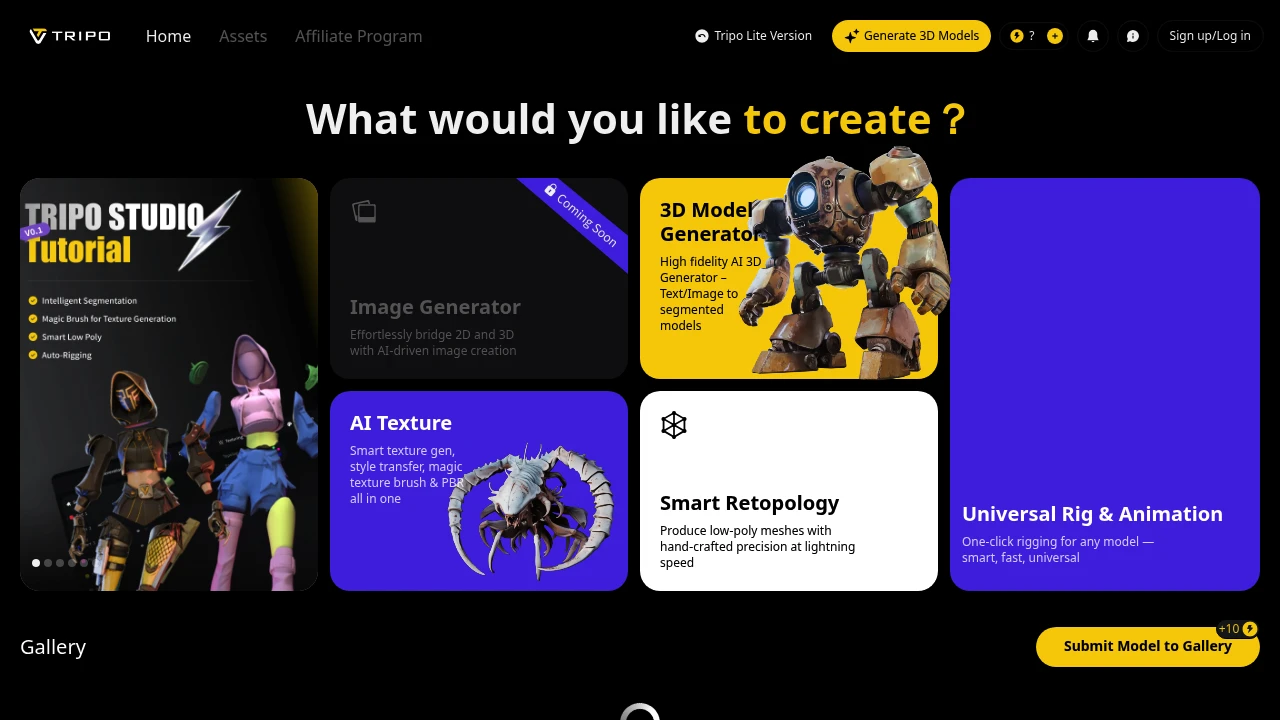Tripo 3D Studio
Tripo 3D Studio generates clean, textured 3D models from prompts or reference images with PBR materials, editing tools, and exports for real engines.

Tripo 3D Studio Features & Overview
Tripo 3D Studio is an AI 3D creation workspace. It converts text prompts and single images into usable meshes with UVs and textures, then gives you practical tools to refine geometry, materials, and lighting before export. The pipeline blends diffusion generation with neural reconstruction to keep shapes consistent across views. It unwraps UVs, bakes PBR maps, and previews results in a real-time viewer. You fine-tune details, fix surfaces, render turntables, and export ready files for engines and DCCs.
Core Features
- Text to 3D generation: Describe an object and receive a mesh with auto UVs, albedo, roughness, and normal maps. You iterate with prompt edits, seeds, and style settings until proportions and surface detail match your intent.
- Image to 3D from a single photo: Upload a reference and reconstruct a complete model with inferred backsides and filled occlusions. The system preserves scale cues from the image and targets watertight geometry for easier downstream edits.
- Real-time 3D viewer: Inspect topology, materials, and lighting in an interactive viewport. Switch environments, toggle wireframe, and scrub a turntable to catch shading issues before you export to your pipeline.
- UV unwrapping and texture baking: Generate clean UV layouts and bake PBR maps at practical resolutions. The baker reduces seams on curved surfaces and aligns texel density so decals and labels stay crisp.
- Mesh cleanup and editing tools: Decimate dense meshes, close small holes, and smooth noisy regions without destroying silhouette. Quick sculpt and transform controls help fix warped parts and restore symmetry when needed.
- Material controls and presets: Tweak roughness, metalness, and normal intensity for believable surfaces. Material presets speed common looks like plastics, fabrics, wood, and painted metal while keeping parameters fully adjustable.
- Reference-guided prompting: Lock color or silhouette from your image and let the model re-render fine detail. Reference weighting keeps key features while allowing creative variations for ideation and A and B options.
- Lighting and render outputs: Test HDRI environments, add simple key and fill, and generate turntable PNG or MP4 renders. Output previews help stakeholders review assets without opening a 3D tool.
- Batch jobs and queue management: Submit multiple generations and track progress in a single panel. You rename results, add notes, and compare variants side by side to pick a hero asset quickly.
- Standards-based export: Export GLB, OBJ, or FBX with embedded or external textures. Choose units and up-axis, package files for Unity or Unreal, and keep a copy of source textures for later paint-overs.
Supported Platforms / Integrations
- Web app workspace
- Export to GLB, OBJ, FBX
- Ready for Blender, Maya, 3ds Max, Cinema 4D
- Engine targets including Unity and Unreal via standard imports
- HDRI libraries and texture packs you already use
Use Cases & Applications
- Game teams blocking and polishing props for levels
- E-commerce and marketing creating product spins and hero renders
- Industrial design turning sketches and references into reviewable 3D
- AR and XR teams generating lightweight assets for prototypes
Pricing
- Free
- Pro: contact sales
- Team: contact sales
- Enterprise: contact sales
Why You’d Love It
- Moves from idea or photo to textured 3D with minimal setup
- Balances AI speed with hands-on controls for polish
- Exports cleanly into real engines and DCC tools
Pros & Cons
Pros
- Fast text and image workflows that produce PBR-ready assets
- Practical cleanup, UV, and baking tools in one place
- Viewer, turntables, and standard exports that fit real pipelines
Cons
- Very intricate parts may need manual retopo in a DCC
- Large batches can require paid capacity
Conclusion Tripo 3D Studio turns prompts and references into workable 3D faster than a traditional modeling pass. You refine materials and geometry, preview lighting, and export in the formats your team already uses. It fits concept sprints, content pipelines, and product visuals without heavy overhead.